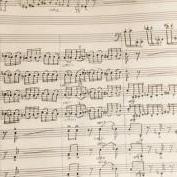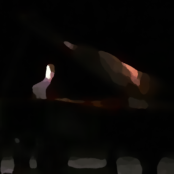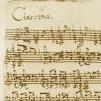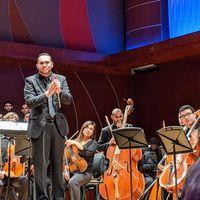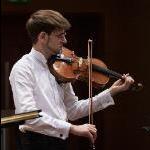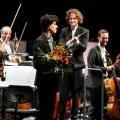Search the Community
Showing results for tags 'concerto'.
-
Hey guys! I'm getting ready to start on my longest piece to date: a 10-minute chamber concerto featuring the oboe as the soloist. Instrumentation (subject to change): Woodwinds - Oboe, Flute, Bb Clarinet, Basson, Bass Clarinet Strings - 4 Violins, 2 Violas, 2 cellos, 2 DB Brass: French Horn, 2 Trumpets I am not sure where to start, so I was hoping to see if anyone had any resources they could recommend, such as words of advice, structural advice, instrumentation, etc. Thank you
-
i invite you to listen to my oboe concerto which is my latest work, these kind of compositions i know how to do best! i hope 😉 in the italian style!
- 4 replies
-
- concerto
- baroque style
-
(and 1 more)
Tagged with:
-
have been working for a while on my first proper attempt at writing a piano sonata. Here is the complete double exposition, albeit un-orchestrated. I would much appreciate feedback + ideas on how to approach writing the development section. The development section is already underway but, it has not reached the same level of completion as the exposition. Also, ideas on orchestration would be appreciated as well as comments on the form. soundcloud.com/louis-fletcher-433112829/concerto-in-b-minor-double-exposition?si=d7e98d79d30642e3add8de4aebcf2e91&utm_source=clipboard&utm_medium=text&utm_campaign=social_sharing Concerto_in_B_minor_-_Development.pdf (59.81 KB)
-
Hi everybody, Going over some unfinished ideas, I came across this fragment. It has some unbalanced parts... But do you think I should retake it? I have made progress with my rhetoric figures, and soon the first entries will be ready... I thin I can use them in any style and I need some fresh different music (than the galant style I was studying).
-
Hi. I've been studying "schemata" (musical formulae) which flourished in the galant style period (1830 - 1870). It's amazing how they used all those chlichés (there were dozens) so fluently. The existed in the baroque period, even before, and would be used for many many years. This is my first attempt to write something in this style. The complex polyphony is no longer wanted, it's more important a melody and bacground. I used some of those schemata: the Romanesca, the Quiescenza, some sequences, falsobordone, Cudworth cadence. I thought bout this piece as en exercise to work with schemata. Perhaps I'll write a second movement with other schemata. (I listened to Vivldi's bassoon concertos as an inspiration, they're fantastic).
-
Hi all, Been away from composition for several months. End of year vacations and some life tribulations were the occasion to let inspiration come back, and after a short string trio I didn't share here, I remembered about this first movement of a cello concerto I had started in summer 2018, letting it aside. So here it is, finished. It may lack some variations and the VSTs don't render the cello's staccato for instance. Hope you'll like it anyway 🙂 Next movements to come in a few weeks/months.
-
Thanks for everyone who voted for my piece in the competition, if people want to see it again or say something about it you can do that here. Have a nice day 🙂
-
The second movement of my piano concerto, I wrote it during the lockdown and I feel like it exemplifies my mood throughout. I'm particularly pleased with the brief piu mosso section. I wanted to upload it with note performer, although I currently don't have my finances in order. so I didn't, if I get it soon I'll re-upload it. Please let me know your thoughts, and I'm working on the final movement, as I'm not short on time.!
-
This is one of my all time favorite pieces by Gubaidulina. I tend to think of this piece as a good example of how unique and eclectic the composer's voice is in our own time. Gubaidulina takes traditional ideas of the concerto and adapts them to the more modern ideals relevant in our own day. An amazing work. I hope everyone enjoys it as much as I have.
-
Hey Im writig a piano Concerto and have hit writers (Composers) block. i'm not convinced with the section at the end which would be the transition to my second subject. any advice welcome. ( i Know i haven't actually put the piano in the score.)
- 8 replies
-
- sonata form
- concerto
-
(and 1 more)
Tagged with:
-
the expositions of my piano concerto in G minor as well as the beginning of the development. any feedback welcome.
-
This piece was begun while I was still studying in Prague. The instrumentation is a straight-forward ode to the Baroque-style of concerto writing, having a more intimate, chamber feel. Moreover, I wanted each of the movements to say both something of the country, as well as recount one of my own memories from my time there. Each movement is therefore a dedication to a particular figure in Czechoslovak history and they move in chronological order (beginning with its independence from the Austro-Hungarian Empire under Masaryk, c. 1918). The first movement recalls a November hike in the outskirts of Prague, where it is far more rural and moderately hilly. I was with a couple of friends and we walked the path until we ended up getting lost, having taken the wrong turn. The music reflects this by consistently ‘losing its place’ and becoming diverted: phrasing is often truncated, the rhythms hesitate in precision, and the oboe frequent reaches to it's higher register in swooning melodies. The piece in essence depicts the Bohemian woods, which are culturally very important. For this reason, I chose Masaryk – the first Czechoslovak president and a symbolic ‘father of the nation’— as the dedicatee for this movement. The second movement is for pacifist teacher Přemysl Pitter, who aided young Jewish, German, and Czech children who were prosecuted/abandoned during and after the Second World War. My professor – who was transfixed on American Quakers and pacifism – had a particular affinity for Pitter, and we visited his house in Žižkov. The piece is primarily tranquil, though the central section is spritely and dance-like. The final movement is dedicated to the first president following the fall of the one-party system in the Velvet Revolution, Václav Havel, who was a playwright. During the communist rule, he was imprisoned several times for his political activities and his writings (via Samizdat). The music is frantic and, at times, scattered, with bits of material struggling to shine through. In essence, sections of the music are ‘censored,’ and themes from all three movements are combined as the music continues.
-
Hi all! I'm new here, and I really wish I'd discovered this community much sooner! I love classical music but, as a violist, my largest complaint has been the lack of stirring, cinematic viola concerti. Well, what's a composer to do? So here's my stab at a full-length viola concerto. I've named it Yfirsést (pronounced ih-ver-syest), the Icelandic word for "overlooked," and an all-too common feeling among violists. This is the first movement, and it resounds with the struggle of overcoming mediocrity and being seen for what you are. (I couldn't tell you what composer it sounds like, because to me, it sounds like me. 🙂) I appreciate your feedback, and especially taking the time to listen! I'll upload the second and third movements (along with the scores for all 3) later.
-
Hi Everyone! My friend recently asked me to write a double bass concerto for her! She told me that she wanted it in G major; I said I will write it for her but the problem is... I HAVE NEVER WRITTEN FOR SOLO DOUBLE BASS IN MY LIFE!!! Can someone please tell me how to write for double bass. Things like scordatura, chords, do's and don't's will greatly be appreciated! (By the way, this concerto is in a classical style so instrumentation is early classical as well.) If you want me to upload it, let me know! Thank You!
- 3 replies
-
- doublebass
- mozartian
-
(and 1 more)
Tagged with:
-
This is a piano concerto I am composing now. I will succesively post remaining movements. The second movement is a slow siciliano, in my feeling it's a bit too short but when I think what I could add, I don't have any ideas :/ what do you think?
-
Hi sorry haven't posted for ages, been busy! Here's the 2nd Movement of my Piano Concerto. I composed it when I was younger, but decided to re-work it. Will be uploading 1st and 3rd movements onto youtube soon. Hope you enjoy. https://www.youtube.com/watch?v=YVs3_spSBD8 Mike
-
This is a piece of which I am very proud. In part, it is dedicated to the city in which I am currently staying -- Prague. This is more than likely my most complex work (structurally), and I hope to use this piece as a learning experience. Here, the viola acts as the leader of the orchestra, which experiences a tremendous journey that spans more than 30 minutes in a contiguous manner. I have included an analysis and I hope that you enjoy!
-
This is my first piece in italian style and generally my first concerto (I don't think it's succesful), I write mostly solo music. What do you think? What do I have to improve?
-
A small concerto (concertino) in a movement. It has a classical style mixed with a "romantic orchestration" It was composed back in 2015 for a 2016 premiere with the High school Concert Band from Escuela Libre de Musica The composition has some novice errors hehe, also I'm conducing, so I apologize for the dancing. I included the audio .midi and the premiere back in 2016 with the Escuela Libre de Musica Concert Band and Angel Cuyar as soloist. As always, feedback is welcomed!
- 3 replies
-
- symphonic
- concert band
-
(and 4 more)
Tagged with:
-
Hello, I wonder how the sound from 0:00 to 1:00 is produced on the piano. Schnittke uses the term con amplificatore which means with amplifier. It almost sounds like some gamelan instruments. Thanks!
-
Hi everyone, After receiving positive comments of my Piano Concerto Mov.1 , I have decided to write the proceeding movements of the concerto, which serves as a challenge to myself. I have long for writing a slow, romantic movement for a concerto and so, in contrast to the 1st Movement, the piano solo has more melodic parts here. How is the work so far? Is the string prologue too long? Btw, I am still trying hard to add woodwinds and brass as I am more familiar with strings, so I may add it later. Thank you for your comments:) Regards, HoYin


(1).thumb.jpg.1336d093d112555a132162dfc44a4d71.jpg)


